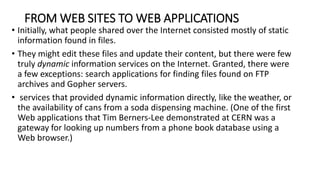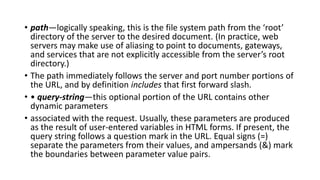Tim Berners-Lee originally proposed the World Wide Web in 1989 at CERN as a system for sharing information over a computer network. It utilized HTML for formatting documents, URLs for uniquely addressing resources, and HTTP for transporting messages. These basic technologies provided the building blocks for the web. HTTP became widely adopted, allowing the proliferation of static web pages in the early 1990s. This eventually led to more complex, dynamic web applications that still rely on HTTP and its request-response model today.

























![THE UNIFORM RESOURCE LOCATOR
• Here is the generalized notation associated with URLs:
• scheme://host[:port#]/path/. . ./[;url-params][?query-string][#anchor]
• Let us break a URL down into its component parts:
• •scheme—this portion of the URL designates the underlying protocol to be used
• (e.g. ‘http’ or ‘ftp’). This is the portion of the URL preceding the colon and two
forward slashes.
• • host—this is either the name of the IP address for the web server being
accessed. This is usually the part of the URL immediately following the colon and
two forward slashes.
• • port#—this is an optional portion of the URL designating the port number that
• the target web server listens to. (The default port number for HTTP servers is 80,
• but some configurations are set up to use an alternate port number. When they
• do, that number must be specified in the URL.) The port number, if it appears,
• is found right after a colon that immediately follows the server name or address.](https://image.slidesharecdn.com/webworldwidedefinationintroduction-240114132239-4907c55f/85/web-world-wide-defination-introduction-pptx-26-320.jpg)

